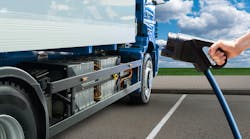I had an interesting conversation with a major industry supplier the other day. We were talking about the transition of trucking from predominantly diesel to predominantly electric. Basically, we were speaking about what we at NACFE call the messy middle.
To review the concept, today we are in a space where legacy diesel-powered trucks dominate the transportation industry with some fleets piloting electric vehicles in some duty cycles. In the messy middle—which we are on the cusp of—we believe many solutions for transporting goods will be optimized. The messy middle will be a time of multiple fuel choices and growing infrastructure for alternative-fueled vehicles. It will be a time of learning, innovation, and maturation of some technologies. Facts will replace suppositions and estimates on what these alternative-fueled vehicles are capable of.
See also: Half of Class 8 regional-haul tractors are electrifiable now, study finds
In the early stages of the messy middle, we will see developments in natural gas, hybrid diesel electric, the first generation of production battery-electric and fuel-cell commercial vehicles, as well as advanced diesel power. As we move on there will be developments in renewable natural gas and diesel and the next generation of battery-electric and fuel-cell commercial vehicles. Toward the end of the messy middle, we will see mature battery-electric and fuel-cell commercial vehicles from clean energy. Eventually, NACFE believes we will get to a future that is all electric from clean energy.
Back to my conversation. While the person I was speaking with agreed on the concept of the messy middle, they wrinkled their nose at the term itself. They shared that the messy middle conjured up something negative.
We don’t see the messy middle as a bad thing. We see it as a time of great change and development and as a bridge to get us from where we are to where we want to be.
The way we see it, we can sit around and wait for zero-emission vehicles to be ready for all applications before investing in them, or we can start to do something now—using alternative fuels today in duty cycles and applications where they make sense.
See also: EV interest is growing and not about to stop
Carbon dioxide reduction is cumulative, so whatever we do right now helps us later. If we wait for the long term, we will miss out on gains in the short term. Conversely, if we just focus on the short term, it could take us longer to achieve our long-term goals.
The work that is being done in the messy middle is very important to reaching climate goals that are essential for our survival.
Don’t let the term messy middle stop you from making investments in technologies today that move us closer to a green future. For NACFE, the messy middle is a good place to be right now.
Michael Roeth has worked in the commercial vehicle industry for nearly 30 years, most recently as executive director of the North American Council for Freight Efficiency. He serves on the second National Academy of Sciences Committee on Technologies and Approaches for Reducing the Fuel Consumption of Medium and Heavy-Duty Vehicles and has held various positions in engineering, quality, sales, and plant management with Navistar and Behr/Cummins.




